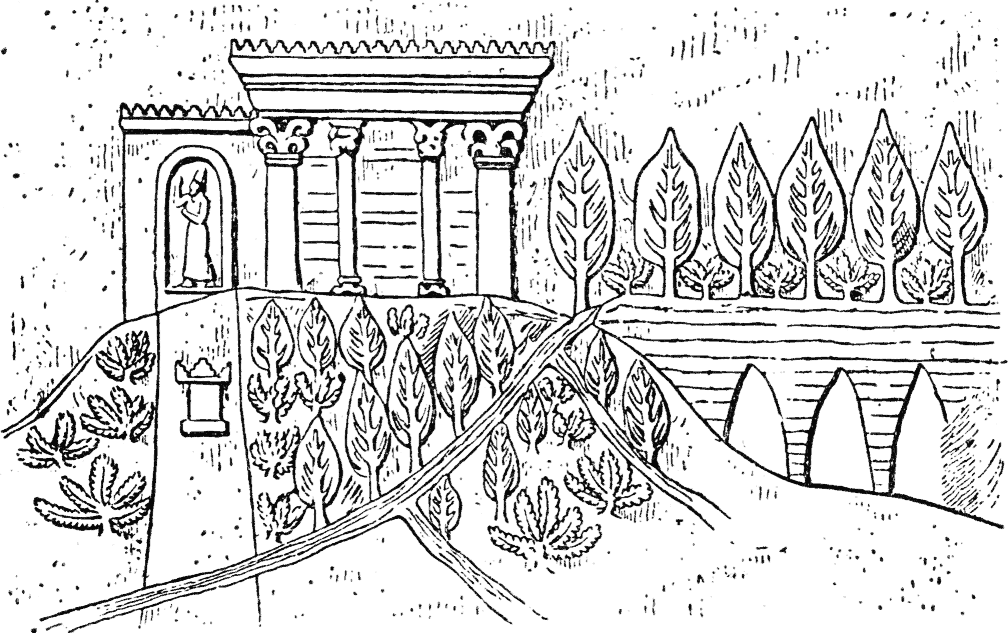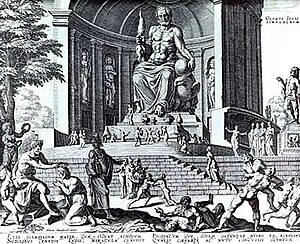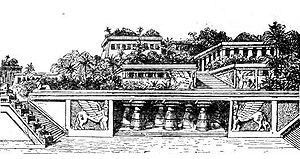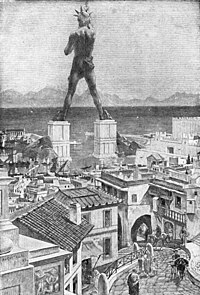Seven Wonders of the Ancient World
Giza pyramid complex
From Wikipedia, the free encyclopedia
Giza pyramid complex (also called the Giza Necropolis) is located on the Giza Plateau near the city of Cairo, Egypt. It is located about eight kilometres (5 mi) inland into the desert from the ancient town of Giza on the Nile, and about 25 kilometres (12.5 mi) southwest of Cairo city centre. The Great Pyramid is the only remaining monument of the Seven Wonders of the WorlHanging Gardens of Babylon
From Wikipedia, the free encyclopedia

The Hanging Gardens of Babylon (also called the Hanging Gardens of Semiramis) and the walls of Babylon (near present-day Al Hillah in Iraq) are one of the Seven Wonders of the World. They were built by Nebuchadnezzar II around 600 BC. He is told to have built the gardens to please his wife, Amytis of Media. She wanted to see the trees and plants of her homeland. The hanging gardens were destroyed in an earthquake after the 1st century BC.
Statue of Zeus at Olympia
From Wikipedia, the free encyclopedia

The Statue of Zeus at Olympia was one of the Seven Wonders of the World. It was carved by the famous sculptor Phidias (5th century BC) around 432 BC in Olympia, Greece.[1]
Temple of Artemis
From Wikipedia, the free encyclopedia

The Temple of Artemis (Greek: Ἀρτεμίσιον Artemision, Latin: Artemisium), also known as Temple of Diana, was a temple dedicated to Artemis. It was completed around 550 BC at Ephesus (in present-day Turkey) under the Achaemenid dynasty of the Persian Empire. Nothing remains of the temple. It was one of the Seven wonders of the World.
Mausoleum of Maussollos
From Wikipedia, the free encyclopedia

The Tomb of Maussollos, Mausoleum of Maussollos, or Mausoleum of Halicarnassus (Ancient Greek: Μαυσωλεῖον Ἁλικαρνασσεύς, Μαυσωλεῖον τοῦ Ἁλικαρνασσοῦ (Ἀλικαρνασσοῦ)), was a tomb built between 353 and 350 BC. It was built at Halicarnassus (present Bodrum, Turkey) for Mausolus Artemisia II of Caria, his wife and sister. He was a satrap in the Persian Empire. It was designed by the Greek architects Satyrus and Pythius.[1][2] It stood about 45 meters (135 feet) tall. Each of the four sides was decorated with sculptural reliefs created by one of four Greek sculptors — Bryaxis, Leochares, Scopas and Timotheus.[3] It was such an accomplishment that Antipater of Sidon said it was one of the Seven Wonders of the World. The word mausoleum has come to be used generically for any grand tomb, though "Mausol – eion" originally meant "[building] dedicated to Mausolus".
Colossus of Rhodes
From Wikipedia, the free encyclopedia

The Colossus of Rhodes was a huge statue of the Greek god Helios. It was built on the Greek island of Rhodes (approximate coordinates 36°27'04"N, 28°13'40"E). It was built by Chares of Lindos, a student of Lysippos. It was built between 292 and 280 BC. It was one of the Seven Wonders of the World. Before being destroyed, the Colossus of Rhodes was 70 cubits tall, over 30 metres (100 feet), making it the tallest statue of the ancient world.[1]
Lighthouse of Alexandria
From Wikipedia, the free encyclopedia
The Pharos of Alexandria (Greek: o Φάρος της Αλεξάνδρειας) was a tall tower built in the 3rd century BC (between 285 and 247 BC). It was built on the island of Pharos in Alexandria, Egypt to serve as the port's landmark, and later, its lighthouse.
With a height estimated at between 115 and 145 meters (384 - 469 ft) it was among the tallest man-made structures on Earth for many centuries. It was identified as one of the Seven Wonders of the World by Antipater of Sidon. It was the third tallest building after the two Great Pyramids (of Khufu and Khafra). Some scholars estimate a much taller height over 180 meters that would make the tower the tallest building up to the 14th century.[needs proving]This piece of art got destroyed by an earthquake.



